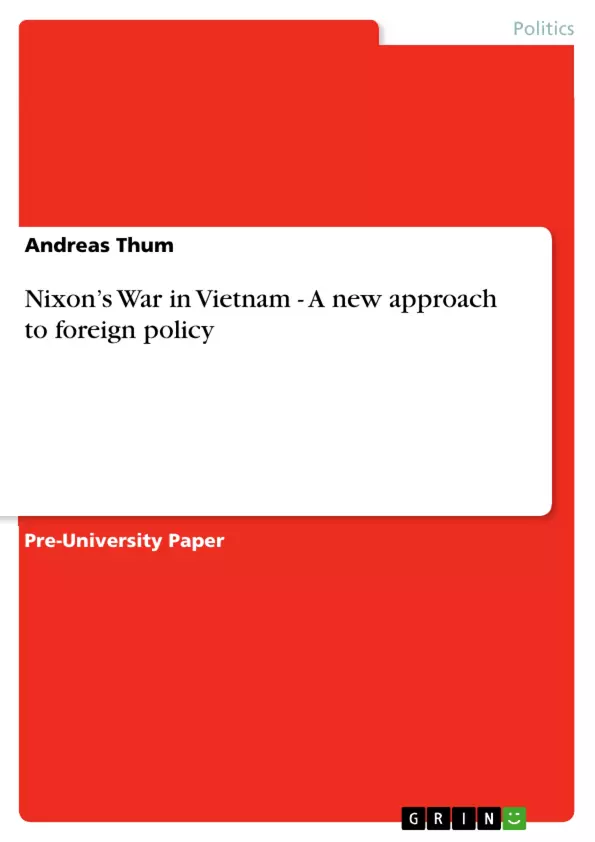Whoever wins the upcoming election and becomes President of the United States, will have to face
the considerable challenge of pacifying Iraq. Although the war has officially ended four years ago,
there still is no peace in sight. No one seems to know how long the U.S. soldiers will have to stay
in Iraq and up to now, no candidate has been able to present an elaborated plan.
In a way, the current events bear some striking similarities to the situation in 1968 when the most
urgent question was, how to end the war in Vietnam. In June of 2007, the approval ratings of the
present office holder George W. Bush fell to 26 percent. There has been only one President who
has ever received an even worse rating. His name was Richard Nixon and he was the man who
won the 1968 election. He was supposed to bring peace to Vietnam. However, this conflict can
only be seen and examined in the context of the Cold War. In order to understand the measures
which Nixon took in Vietnam, one has to take a closer look at his overall concept of foreign policy.
Nixon was one of the most influential and formative politicians of the Cold War era; a key figure
for almost thirty years who essentially defined the politics of his time “by his successes and by his
failures” Much has been written about him and his presidency but nevertheless, Nixon remains a
mysterious character, full of contradictions and open questions.
The aim of this term paper is to respond to the following questions: Who was this man who
polarized the United States like hardly any other president of the 20th century? What were the
cornerstones of his policy? What were his motives, what were his goals? And in which way did his
personality influence or even derogate his actions?
Table of Contents
- Introduction
- Richard Nixon
- Short Biography
- Aspects of Nixon's Personality
- History of the Vietnam War (1945-1968)
- Richard Nixon's Cold War Policy
- The 1968 Election Campaign
- The Initial Position
- The Nixon Doctrine
- Détente with the Soviet Union and China
- Vietnamization and U.S. Withdrawal
- Cambodia and Laos
- Negotiations with North Vietnam
- Nixon's Carrot and Stick Policy
- The Paris Peace Accords
- The Aftermath
Objectives and Key Themes
This term paper aims to investigate the life and political career of Richard Nixon, focusing on his involvement in the Vietnam War and his overall approach to foreign policy. It seeks to answer questions about his personality, motives, goals, and the impact of his actions during the Cold War era.
- Richard Nixon's personality and its influence on his political decisions
- Nixon's foreign policy objectives and strategies during the Cold War
- The Nixon Doctrine and its implications for the Vietnam War
- The role of détente in Nixon's foreign policy
- The process of Vietnamization and U.S. withdrawal from the Vietnam War
Chapter Summaries
The introduction sets the stage for the paper by drawing parallels between the situation in Iraq in 2007 and the Vietnam War in 1968. It emphasizes the importance of understanding Nixon's foreign policy in the context of the Cold War to comprehend his actions in Vietnam.
The first chapter provides a brief biography of Richard Nixon, tracing his career from his early years to his presidency and subsequent resignation. It explores his political rise as an anti-communist and his involvement in the House Un-American Activities Committee. The chapter also examines key aspects of his personality, highlighting his complexity, distrust of others, and tendency towards secrecy.
The second chapter examines the history of the Vietnam War from 1945 to 1968, providing context for Nixon's involvement in the conflict. It explores the events leading up to the escalation of U.S. involvement and the political climate in the United States at the time.
The third chapter delves into Richard Nixon's Cold War policy, starting with his 1968 election campaign. It analyzes his initial position on the Vietnam War, the development of the Nixon Doctrine, and his strategy of détente with the Soviet Union and China. The chapter also examines the Vietnamization process, the U.S. withdrawal from the war, and Nixon's involvement in Cambodia and Laos.
Finally, the chapter explores the negotiations with North Vietnam, focusing on Nixon's "carrot and stick" approach and the eventual signing of the Paris Peace Accords. The chapter concludes by examining the aftermath of the war and its long-lasting consequences.
Keywords
Richard Nixon, Vietnam War, Cold War, foreign policy, Nixon Doctrine, détente, Vietnamization, U.S. withdrawal, Paris Peace Accords, personality, distrust, secrecy, anti-communism, political career, Cold War era, Cold War politics, foreign policy strategies, international affairs, historical analysis, Cold War context.
- Citation du texte
- Andreas Thum (Auteur), 2007, Nixon’s War in Vietnam - A new approach to foreign policy, Munich, GRIN Verlag, https://www.grin.com/document/198006



